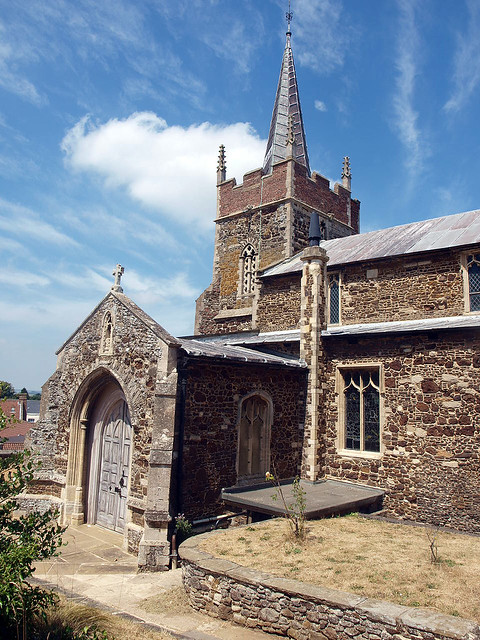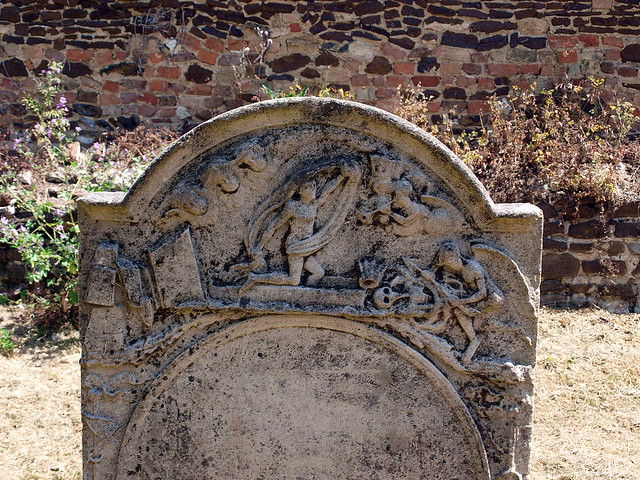Now I know, this being my 1306th visit, that I find only 64.40% of churches accessible and that by now I shouldn't be quite so pissed off when I find a church that should obviously be open locked - and yes I know that I don't know if they've had arsonists, satanists or thieves here - but the same old arguments for keeping a church open apply. It annoyed me so much that I missed the cemetery as I drove off to Ryston, in a toddlers huff.
Having said that the church and churchyard is a delight.
ST EDMUND. Elevated and away to the E of the A10 traflic. Of carstone. W tower E. E., and high. The bell-openings have two lights with a separating round shaft. The lights have pointed trefoiled heads and there is a quatrefoil pierced through the spandrel. A later stair-turret, of brick in its upper parts, cuts into the N bell-opening. Brick battlements and recessed lead spire. In the N aisle two lancets amid Perp windows. Are they re-set? The S aisle also has Perp windows. Those at the W end of both aisles have stepped transoms with battlements. Perp S porch and Perp N doorway. An odd small doorway in the E wall of the S chapel. The chancel is all renewed externally. The arcades inside are confusing. The N arcade is an even five bays with octagonal piers and moulded arches, the S arcade consists of two wide, tall, then two narrow, low arches, and then again one wide, tall arch. All piers are octagonal. The first two bays have moulded arches, the other three double-chamfered ones. It seems likely that the original church had a S transept and ended to the W, where the narrow bays end, that it was then linked up with the new tower, and that in the C14 the piers and arches were renewed. Nave roof with tie-beams alternating with angel figures against the principals. Perp chancel arch with castellated capitals. Wide openings to the S chapel. The opening to the N chapel and the chapel itself are of 1873. - FONT. Octagonal, with angels holding shields with emblems. - SCULPTURE. A Gothic Crucifixus in relief above the chancel S door. - A spiral-fluted Norman colonnette outside the N transept chapel. - WEST GALLERY. Of wood, C18, handsome. - PLATE. Cup, probably 1587; Paten, 1690; Chalice, 1701; Paten Cover, Paten, and Flagon, 1728.
DOWNHAM MARKET. To this small market town looking over the valley of the Ouse came two boys to the school kept by Thomas Nooks and William Chatham. They were Horatio Nelson, son of the parson of Burnham Thorpe, and George Manby of Denver, who invented the life-saving rocket, and often must the two friends have stood together on the bridge spanning the river, looking at the church with the low tower and the little spire crowning the hill. Long before their names were in all men’s mouths, another who belongs to English history sought the town as a lodging or a refuge, for it is one of the many places where Charles Stuart is said to have stayed after Naseby. Here he came on May Day 1646, disguised as a clergyman.
The town hall and the clock tower in the small marketplace have come since Nelson’s day, and the church, reached by a long avenue of elms, is largely 15th century as we see it outside. A reminder of the original Norman church is a small shaft set in the outside wall of the chapel. The oak panels high on the sanctuary wall were once the altar rails, and a fine old chest like a family trunk has massive iron bands and three locks. The 15th-century font has eight shields carved with emblems of saints. Since the close of last century the angels and saints adorning the roof, which are said to have been battered by soldiers in the Civil War, have been looking down in their bright new dress. Men holding shields are supporting the beams. The screen and pulpit are both canopied, and enriched with gold leaves and roses.
A tribute to a grocer who died in 1751 tells how by his honesty he acquired a genteel fortune and a universal good name.
The town hall and the clock tower in the small marketplace have come since Nelson’s day, and the church, reached by a long avenue of elms, is largely 15th century as we see it outside. A reminder of the original Norman church is a small shaft set in the outside wall of the chapel. The oak panels high on the sanctuary wall were once the altar rails, and a fine old chest like a family trunk has massive iron bands and three locks. The 15th-century font has eight shields carved with emblems of saints. Since the close of last century the angels and saints adorning the roof, which are said to have been battered by soldiers in the Civil War, have been looking down in their bright new dress. Men holding shields are supporting the beams. The screen and pulpit are both canopied, and enriched with gold leaves and roses.
A tribute to a grocer who died in 1751 tells how by his honesty he acquired a genteel fortune and a universal good name.



No comments:
Post a Comment